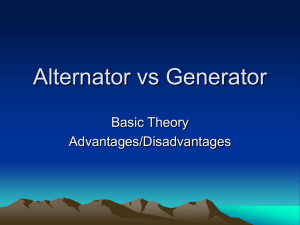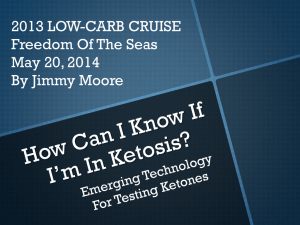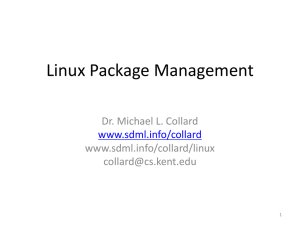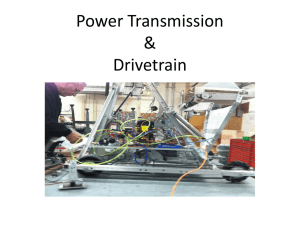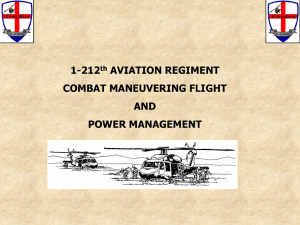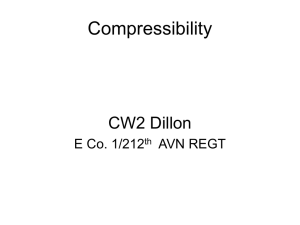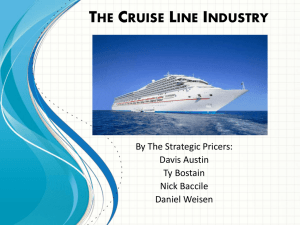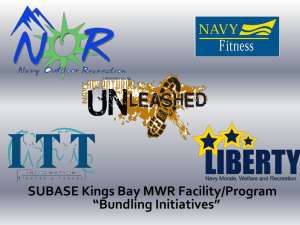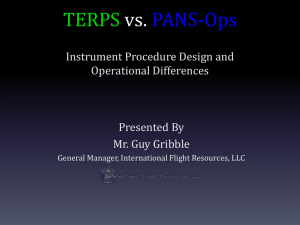Flight Procedures 2
advertisement
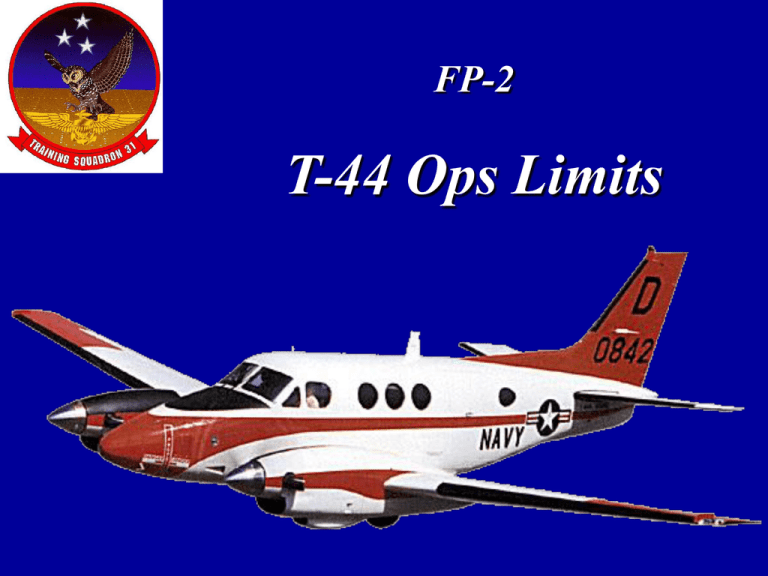
FP-2 T-44 Ops Limits Overview • • • • • • System Limitations Propeller Limitations Starting Limitations Engine Limitations Airspeed Limitations Miscellaneous Limitations Instrument Markings Limit above or below which continued operation is likely to cause damage or shorten life Safe or normal range of operation Special attention should be given…Operation is permissible, but should be avoided Power Definitions Max Allowable Max power available from the engines for takeoff. Time limited to 5 minutes. Max Continuous Max power available from the engines not time limited. Intended for emergency use. Cruise Climb The maximum power approved for a normal climb. Cruise Power required to maintain level flight at a desired altitude and normal airspeed. Cruise power will vary w/ altitude & airspeed. Propeller Limitations Propeller RPM (N2) Normal: 1800 - 2200 RPM Maximum: 2200 RPM Acceleration: 2420 RPM (2 sec) Max Reverse: 2100 RPM 900-1100 RPM Idle: --> else low pitch torque check Overspeed Test: 1900-2100 RPM Overspeed Gov: 2288 +/- 40 (4%) Fuel Topping: 2332 RPM (6%) --> resets overspeed gov Note: N2 limits are NOT propeller limitations, but instead correspond to stress limits of the engine power section Starter Limitations Starting Limitations Min VDC for APU Charge 18 VDC Min VDC for APU Start 20 VDC Min VDC for Batt Start 22 VDC Starter Cycle: 40 sec on, 60 sec off 40 sec on, 60 sec off 40 sec on, 30 min off Start ITT Limitations 1. ITT 1090 ____ deg C for __ 2 seconds -- ITT approaches 925 ___ deg C -- Stop start, check BATT, APU start? -- Report temp & duration if > 925 deg C 2. ITT on operative engine approaches 790 ___ deg C -- Stop start -- Reset N1 to 85 percent & reattempt the start Engine Limitations Engine Torque Max Time RPM RPM 2200 1900 Max Allowable 5 Minutes 1315 Max Continuous Continuous 1315 1520 1520 Cruise Climb Continuous 1315 1520 1520 Cruise Continuous 1315 1520 1520 Acceleration 2 Seconds 2100 Condition Note 1: Torque limits between 1900 and 2200 RPM vary linearly between 1315 and 1520 Ft-Lb ITT Condition Max Allowable Max Continuous Cruise Climb Cruise Lo-Idle Starting Acceleration Max Reverse Max Time 5 Minutes Continuous Continuous Continuous Continuous 2 Seconds 2 Seconds 1 Minute Max ITT 790 790 790 790 765 765 740 740 685 685 1090 1090 850 850 790 790 Note 1: High ITT in Lo-Idle may be decreased by reducing accessory load and/or increasing N1 speed Note 2: High gen loads at low N1 speeds may cause the ITT acceleration temp limit to be exceeded. Observe the generator load limits for specific N1 speeds (See chart in NATOPS, pg. 4-5). CAUTION Engine torque and ITT limits are determined by ambient temperature. During operations requiring maximum engine performance, be aware of whether torque, or ITT limits govern. Remember, cold temperature or low altitude - torque limited, while hot temperature or high altitude is ITT limited. N1 % Condition Max Allowable Max Continuous Cruise Climb Cruise Acceleration Max Reverse Max Time N1 % 5 Minutes Continuous Continuous Continuous 2 Seconds 1 Minute 101.5 101.5 101.5 101.5 102.6 86 Note 1: Ground operations above 3500 foot pressure altitude (PA) may produce idle speeds as high as 83-percent N1 at low idle. Note 2: For every 10 deg C below -30 deg C ambient temperature, reduce maximum allowable N1 by 2.2% Anybody from Wyoming??? Oil Pressure & Temperature Condition Max Allowable Max Continuous Cruise Climb Cruise Hi-Idle Lo-Idle Starting Acceleration Max Reverse Max Time PSI 5 Minutes Continuous Continuous Continuous Continuous Continuous -----2 Seconds 1 Minute 85 - 100 85 - 100 85 - 100 85 - 100 -----40 (min) ----------85-100 Deg C 10 - 99 10 - 99 10 - 99 10 - 99 -40 - 99 -40 - 99 -40 (min) 10 - 99 10 - 99 Oil Pressure & Temperature Notes -- Normal oil pressure is 85-100 PSIG at power settings above 72% N1. -- Oil pressure below 85 PSIG is undesirable and may be used only for completion of a flight, and then at a reduced power setting. Low oil pressure should be corrected prior to next flight. -- During ground operations, oil pressures below 40 PSIG require engine shutdown -- During flight, oil pressure below 40 PSIG is unsafe and requires either engine shutdown or use of minimum power until a landing can be made. Airspeed Limitations 25 Airspeed Limitations Aircraft Speed SL to 15,500 FT 227 KIAS Aircraft Speed 15,500 - 30,000 FT See Note Smooth Air Gear & Flaps Down 140 KIAS Turbulent Air Gear & Flaps Down 140 KIAS Landing Gear Extension 155 KIAS Landing Gear Retraction 145 KIAS Flaps Extension 35% (App) 174 KIAS Flaps Extended 100% (Full) 140 KIAS Note: Decrease speed 4 KIAS for every 1000 ft above 15,500 ft Miscellaneous Limitations Fuel Management ** Do not takeoff if gauges are in the yellow arcs or < 265 lbs ** AVGAS is limited to 150 hours before overhaul ** Both boost pumps must be operable prior to takeoff ** Suction boost limited to 10 hrs between fuel pump overhaul Weight Limitations Max Ramp 9710 lbs Max Takeoff 9650 lbs Max Landing 9168 lbs Caution The following actions may result in aircraft damage and SHALL be avoided: -- Landing on arresting gear cable -- Nosewheel contact with cable risers above taxi speed -- Braking during cable rollover -- Operation above taxi speed over arresting gear rigged with boots (tire segments) Questions ???

